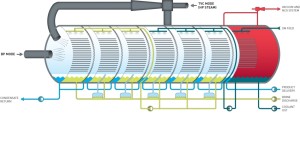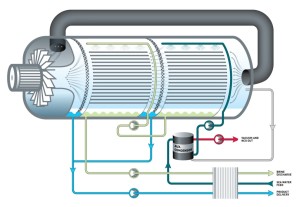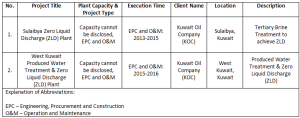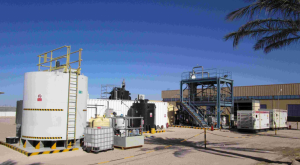New, strict environmental rules around the world very often impose the requirement of treating reject waters coming from water treatment plants or other industries, where water is used, to achieve zero liquid discharge instead of disposing it back to the sea/other natural reservoir.
AquaSwiss offers Zero Liquid Discharge solution using its differentiating low temperature, low chemical footprint, cost effective thermal technologies.
Below are descriptions of Concentrator and Crystallizer used in the AquaSwiss ZLD solution:
1. Concentrator: A Multi Effect Distillation (MED) or Mechanical Vapour Compression (MVC) evaporator positioned as the first stage of the process,.
There may be a fit-for purpose pre-treatment before entering the Concentrator, such as DAF, Clarifier, Filtration etc to obtain pure water as a final product and highly concentrated brine, which is normally disposed as a waste.
The product water can be designed to have any TDS from 5 ppm to 1’000 ppm dependent on the application of product water.
Multi Effect Distillation (MED)
Low temperature multi effect distillation is a simple, reliable and efficient process utilizing low cost / low grade heat or waste steam. Vacuum enables operation at unparalleled low distillation temperatures (below 70 °C) minimizing scale and corrosion, and hence maintenance, to an absolute minimum. A large number of effects consequently results in very high economy ratios (product to steam) and the use of aluminum tubes improving the heat transfer results in lower investment cost compared to conventional high temperature processes.
With extremely safe evaporators, evaporation and condensation are achieved by direct transmission of latent heat, avoiding sensible heat pickup, which would decrease the effective temperature differential. Using the falling film concept, static head is eliminated from the flashing process and high evaporation heat transfer coefficients result.
AquaSwiss uses all standard items of equipment in the plant of high quality and reliable design, purchased only from reputable international manufacturers.

Mechanical Vapour Compression (MVC)
MVC distillation is the most thermodynamically efficient process of single-purpose thermal desalination. The thermodynamic efficiency is derived from the application of the “heat pump” principle by a large volumetric flow compressor acting as the “heat pump”, which continuously recycles and keeps the latent heat exchanged in the evaporation and condensation steps within the system. The heat required to evaporate part of the processed feed, which flows on one side of a heat transfer surface, is supplied through the simultaneous condensation of the distillate, on the other side of the surface. This cycle of evaporation and condensation operates continuously. The principle is similar to our MED.
MVC units are standard, factory-assembled and skid mounted units, proven by strict and thorough prototype testing at an R&D centre and by years of satisfactory experience with commercial plants operating throughout the world. The plants are simple, efficient and automatic.
The quality of the product water from the MVC unit exceeds public health standards by a wide margin. Typical applications are for downstream oil companies, oil facilities, refineries, petrochemical plants, industries like cement, tourism, factories, chemical plants etc.

Concentrator can be powered purely by electricity (MVC), although utilizing waste or low pressure steam as a power (MED) is more cost effective solution.
2. Zero Liquid Discharge using a Crystallizer
Instead of disposal of concentrated brine as a waste, it is treated in the next process stage utilizing Crystallizer to recover all the liquid up to 99% leaving dry salts/ sludge as the by-product. This process is called Zero Liquid Discharge (ZLD)
The technical brief of a typical Steam Driven Crystallizer is elaborated below.
Steam Driven Crystallizer
The crystallization process has long been used in the manufacture of commodity chemicals such as sodium chloride and sodium sulphate. However, unlike commodity production where only one salt precipitates, typical reduction of industrial waste to dryness involves crystallizing multiple salts. This type of mixed salt crystallizer requires significantly different design parameters to avoid problems such as severe foaming and rapid scaling. Furthermore, mixed salt solutions have significantly high boiling point rises requiring detailed attention to design parameters when sizing vapour compressors.
Innovative filtering techniques have been developed to reduce the cost of smaller crystallizer systems.
Crystallizers typically have an external heater in which the solution is heated by steam in the shell. The heated solution then flashes into a large vessel called a vapor body. The heater tubes are flooded, with boiling water in the tubes suppressed by the liquid elevation in the vapor body (submergence). A slipstream is drawn off into a solids separation device (a centrifuge) and crystals are removed. Different energy sources are used.
Steam Driven Crystallizer with Thermo-compressor
Steam enters the thermo-compressor and a portion of the vapor that is evaporated in the vapor body is recycled to the suction of the thermo-compressor. Then the steam enters the heater shell. This configuration typically results in 20 – 30% reduction in steam usage. A condenser is required to condense the remainder of the vapor that is not recycled to the thermo-compressor.

Use of renewable energy for the stated process scheme
Concentrated Solar Panel (CSP) technology can be used for steam production for the Steam Driven Crystallizer as well as molten salt storage to operate the plant during night time. For the realization of a large scale plant, the use of CSP can be evaluated in case there is no waste heat available to operate the Steam Driven Crystallizer.
The electricity needed can be generated by photovoltaic (PV) solar panels.
Application of Zero Liquid Discharge (ZLD)
ZLD can be used pretty much anywhere in industrial environments where disposal into rivers, ground or sea is not permitted for environmental / ecological reasons.
Some common ZLD workflows include:
- Treatment of Produced Water from Oilfields
- Treatment of Industrial Effluents
- Treatment of Effluent from Power Plants
AquaSwiss ZLD Reference Plants

Pictures from KOC Sulaibya ZLD reference plant:

Pictures from KOC West Kuwait Produced Water Treatment & ZLD reference plant:






